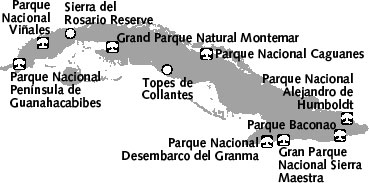Itineraries
CLASSIC ROUTES
CULTURE VULTURE
BEACHES
ROADS LESS TRAVELED
CUBA THROUGH THE BACK DOOR
THE MUSICAL TOUR
TAILORED TRIPS
BOOK TOUR
BIRD-WATCHING CUBA
ISLANDS IN THE ARCHIPELAGO
PARKS & RESERVES
CLASSIC ROUTES
CULTURE VULTURE Two to Three Weeks / Havana to Baracoa
Say a big warm buenos días to Cuba in Havana with its museums, forts, theaters and rum. Pinar del Río is tobacco country and its scenic highlight is Viñales, where farmers grow the stuff with skill and amor (love). On most itineraries these days is French-flavored Cienfuegos, an architectural monument to 19th-century neoclassicism. A couple of hours down the road is colonial Trinidad with more museums per head than anywhere else in Cuba. Santa Clara is a rite of passage for Che pilgrims but also great for smart private rooms and an upbeat nightlife. Further east, Camagüey is a confusing maze of Catholic churches and giant tinajones (clay pots). You can bypass Las Tunas, but you’d be foolish to miss gritty Holguín which is about as real as Cuba gets. Laid-back Bayamo is where the Revolution was first ignited, but the cultural nexus of Santiago de Cuba was where it was conceived. Save the best till last with a long but by no means arduous journey over the hills and far away to Baracoa for coconuts, chocolate and other tropical treats.
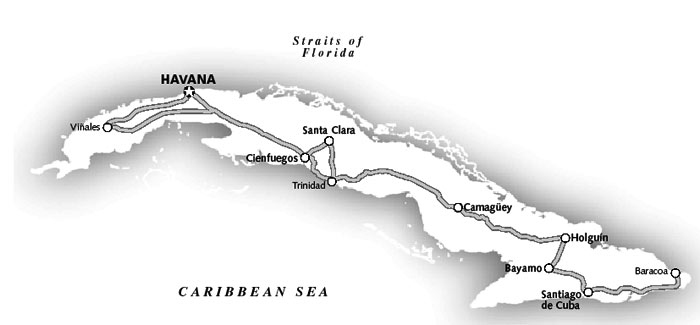
Return to beginning of chapter
BEACHES Two Weeks to One Month / Playa Santa María to Playa Paraíso
From the capital, colorful Playa Santa María is the most easily accessible beach, an exuberant mélange of makeshift fish barbecues, beach-volleyball tournaments and wandering troubadours. Tracking west it’s a toss-up between low-key Cayo Levisa and even lower-key Cayo Jutías, so why not throw the dice away and hit both. There’s a reason why Varadero boasts more tourists than any other resort in the Caribbean and 20km-long diamond-dust Playa Varadero might well be it. Few beaches adorn Cuba’s swampy south coast, making platinum blond Playa Ancón all the more gorgeous. Of the few remaining public beaches on Villa Clara’s Cayerías del Norte, Playa Las Salinas is a windswept classic. Guarding the biggest sand dunes on the archipelago, Playa Pilar is the one Cuban beach worthy of a ‘world top 10’ listing. Playa Santa Lucía competes with Varadero as the island’s longest beach (20km plus), but beats it hands down on the diving front. Postcard-perfect Playa Pesquero in Guardalavaca is paradise found for many, with a 933-room, five-star resort to match. White sand? What white sand? Granma’s southern coast is more Big Sur than Palm Beach, but the wildness of the setting adds romanticism to an evening walk on the beach at Marea del Portillo. It rains at least half the year on Playa Maguana, but when the sun breaks out, so do the locals, with their swimming costumes, snorkels and Baracoan sense of fun. If you’d rather leave your swimming costume at home, you’ll need to jump on a flight to Playa Paraíso Click here on the tiny island of Cayo Largo del Sur, where Cuba’s only nudist colony basks in almost perfect seclusion.
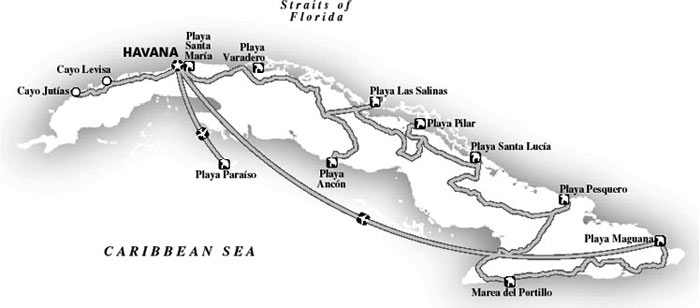
Return to beginning of chapter
ROADS LESS TRAVELED
CUBA THROUGH THE BACK DOOR One Month / Playas del Este to Siboney
Boycott Havana and head east to the beaches of Playas del Este, where private houses and picturesque sunsets abound, or leapfrog straight to Santa Cruz del Norte, a worthwhile base camp situated within hiking distance of the golden sands of Playa Jibacoa. Switch west next along the beautiful (and deserted) northern coast route to Puerto Esperanza for a few days of turning off, tuning in and dropping out before pressing on to Sandino, within striking distance of María la Gorda. The Bahía de Cochinos (Bay of Pigs) area is awash with decent casas particulares, none better than those found on shimmering Playa Larga, and you can easily work your way along the coast from here to Rancho Luna and La Boca, where assorted private houses offer up an ideal antidote to the tourist hotels of Cienfuegos and Trinidad. The long road east presents ample opportunities to avoid the city hustlers in Ciego de Ávila and Camagüey. Check out unsung Florida with its archetypal sugar mills, or bustling Guáimaro with its groundbreaking constitutional history. Turn left in Las Tunas and detour to the remote northern beach ‘resort’ of Playa Las Bocas, where you’ll see no one but a handful of ingratiating casa particular owners. Homing in on Holguín province, check out the pretty town of Banes as a launching pad for Guardalavaca before making one last fling down to Santiago de Cuba, where peace and tranquility await you in sleepy Siboney.
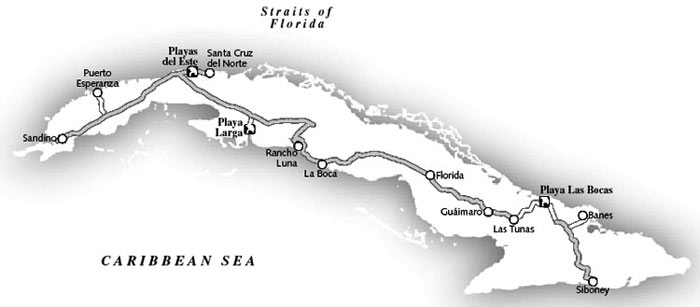
Return to beginning of chapter
THE MUSICAL TOUR Two Weeks to One Month / Havana to Baracoa
Ease in gently at Havana’s Iglesia de San Francisco de Asís, where refined classical music echoes eerily through the cloisters of a converted 18th-century church. Next shimmy a couple of blocks west to Mesón de la Flota, where rasping vocals and furious flamenco invites listeners to discover the elusive spirit of what aficionados call duende (a term used in flamenco to describe the ultimate climax to the music). For something more authentically Cuban, visit Havana’s Casa de la Música in El Centro, or forge your way west to venerable Viñales, home of the guajira (a type of flamenco) and location of the spanking new Centro Cultural Polo Montañez. In unsung Matanzas, live rumba performances reverberate in Plaza de la Vigía Click here while, an hour or two further on, in Santa Clara’s Club Mejunje, loose rhythms and heavy bass mix in one of Cuba’s most vibrant and underrated cultural institutions. Trinidad has trova (traditional poetic singing) and son (Cuba’s popular music) and a lot more besides in Palenque de los Congos Reales, while the long journey east to Santiago’s spit-and-sawdust Casa de las Tradiciones is a musical homecoming, akin to sailing down the Mississippi to New Orleans. With the hangover starting to bite, tie in Haitian drums and voodoo rhythms in Guantánamo’s Tumba Francesa Pompadour before heading over the Sierra Puril Mountains for the grand finale: a frenetic all-out Cuban knees-up at the amiable Casa de la Trova in Baracoa.
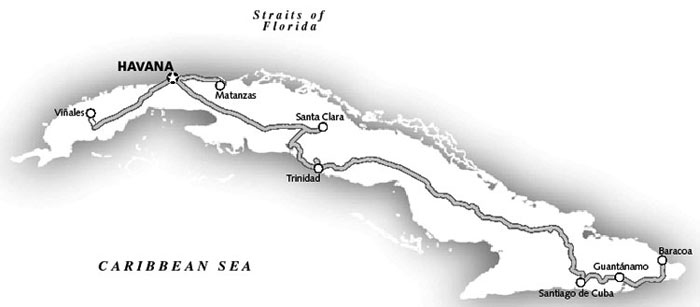
Return to beginning of chapter
TAILORED TRIPS
BOOK TOUR
Start off in Havana in the Hotel Sevilla, which Graham Green borrowed as a setting in his comedic novel Our Man in Havana. Head east next through Centro Habana, the seedy, mildewed quarter disturbingly brought to life by ‘dirty realist’ author Pedro Juan Gutiérrez in Dirty Havana Trilogy. Stop at the Monumento a las Víctimas del Maine to recall the historical events chronicled so eloquently by Elmore Leonard in Cuba Libre. Don’t leave town without first calling in at Uneac and La Casa de las Américas, where bookish intellectuals trade tall stories. Take a beach break next on Cayo Guillermo, a fishing key to which Hemingway paid homage in Islands in the Stream. South and a little east is Camagüey, birthplace of Cuban national poet and Uneac founder Nicolás Guillén. Low-key Gibara produced and inspired Guillermo Cabrera Infante, the Cuban Joyce whose Tres Tristes Tigres is often called ‘the Spanish Ulysses.’ Dos Ríos provides one of the most poignant monuments to the ubiquitous José Martí – writer, poet, sage and politician. In Santiago de Cuba you’ll find the Casa Natal de José María de Heredia Click here, another classy Cuban poet. Close the book in Baracoa, the magical town that provided both the characters and backdrop for Alejo Carpentier’s classic La Consagración de la Primavera.
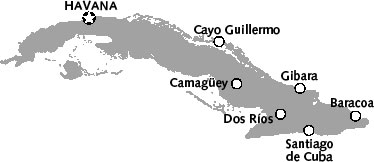
Return to beginning of chapter
BIRD-WATCHING CUBA
With your binoculars polished, sally forth into the verdant Valle de Viñales where, with a bit of patience and the help of the locals, you can catch glimpses of Cuban bullfinches or chirpy Cuban peewees. The Península de Guanahacabibes has virgin beaches and dense flora that attracts everything from tody flycatchers to migratory ruby-throated hummingbirds. Don’t overlook the Sierra del Rosario Reserve, where it’s possible to spot up to 50% of Cuba’s endemic birds, including the often elusive carpinteros. The Gran Parque Natural Montemar is a huge protected area encompassing Cuba’s largest wetland. Wait around for a few hours (or days) and you might see a zunzún – the world’s smallest bird. In Topes de Collantes keep an eye out for the bright red, white and blue tocororo (Cuba’s national bird), then venture into Cayo Romano to get a look at some of the island’s more than 30,000 flamingos. La Hacienda la Belén Reserve near Camagüey promises glimpses of Cuban parakeets, giant kingbirds and Antillean palm swifts. While the journey might appear long and the hiking arduous, no Cuban birding adventure is complete without a visit to the almost virgin Parque Nacional Alejandro de Humboldt for viewings of Cuban Amazon parrots, hook-billed kites and – unlikely but not impossible – ivory-billed woodpeckers last spotted here in the early 1980s.
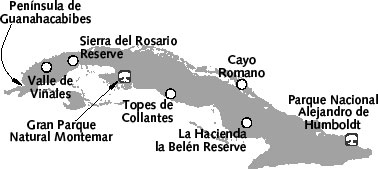
Return to beginning of chapter
ISLANDS IN THE ARCHIPELAGO
Hotel-free Cayo Jutías is the highlight of the Archipelago de los Colorados, the necklace of quiet keys that stretches west from Havana. If you need a room for the night, catch the boat to Cayo Levisa, its more developed but equally beautiful eastern sibling. Leapfrogging Havana, you’ll have to go upmarket on Cayo Ensenachos, where a plush new resort has embellished (and privatized) one of Cuba’s most stunning beaches. Three keys on the huge Sabana-Camagüey archipelago are linked to the mainland by a massive causeway. Cayo Guillermo plays heavily on its Hemingway connections; Cayo Coco, Cuba’s fourth-largest island, is replete with large resorts; while uninhabited Cayo Paredón Grande guards a solitary lighthouse, a couple of fine beaches and plenty of fishing possibilities. Heading east on another causeway to Cayo Romano, the tourists are replaced by flamingos, mosquitoes and plenty of interesting birdlife. Cayo Sabinal with its lighthouse and old Spanish fort is a favorite of many, while tiny Cayo Saetía has a safari park with exotic African fauna. For real Robinson Crusoe–like isolation you’ll need to charter a trip to the Jardines de la Reina, a chain of 600 uninhabited keys where the only accommodation is on a floating hotel. It’s not particularly Cuban, but tourists love Cayo Largo del Sur for its visiting turtles and Cuba’s only nudist beach.
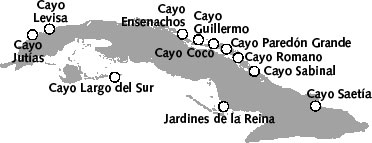
Return to beginning of chapter
PARKS & RESERVES
On the island’s western tip, the Parque Nacional Península de Guanahacabibes is home to crabs, turtles, archaeological sites and not many humans. Further east but also in Pinar del Río province, the karstic, cave-flecked Parque Nacional Viñales is a Unesco World Heritage Site that exhibits the fine art of Cuban tobacco-growing. Pinar’s third Unesco site is the Sierra del Rosario Reserve, an oft-lauded biosphere and site of the country’s most successful environmental reclamation project. Cuba’s biggest protected area, the expansive Grand Parque Natural Montemar, is also the Caribbean’s largest swamp and ideal for bird-watching, fly-fishing and spotting the odd sun-bathing crocodile. Topes de Collantes in the Sierra Escambray is one of the island’s most accessible and popular protected parks and has a plethora of waterfalls and junglelike trails. To the north, Parque Nacional Caguanes is a little-visited mix of mangrove and marine park that sits amid the Buenavista Unesco Biosphere Reserve. Parque Nacional Desembarco del Granma is a collection of plunging marine terraces where Fidel Castro mistakenly landed aboard his stricken yacht in 1956. Nearby, Cuba reaches its highest point in the Gran Parque Nacional Sierra Maestra, home of 1972m Pico Turquino. Parque Baconao Click here is a strange mix of ruined coffee haciendas, sheltered beaches and surreal stone dinosaurs. Things get clearer in the Parque Nacional Alejandro de Humboldt, an almost virgin Caribbean rainforest that registers Cuba’s highest levels of endemism.
